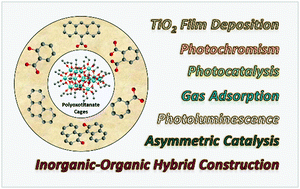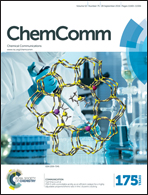Novel properties and potential applications of functional ligand-modified polyoxotitanate cages
Abstract
Functional ligand-modified polyoxotitanate (L-POT) cages of the general type [TixOy(OR)z(L)m] (OR = alkoxide, L = functional ligand) can be regarded as molecular fragments of surface-sensitized solid-state TiO2, and are of value as models for studying the interfacial charge and energy transfer between the bound functional ligands and a bulk semiconductor surface. These L-POTs have also had a marked impact in many other research fields, such as single-source precursors for TiO2 deposition, inorganic–organic hybrid material construction, photocatalysis, photoluminescence, asymmetric catalysis and gas adsorption. Their atomically well-defined structures provide the basis for the understanding of structure/property relationships and ultimately for the rational design of new cages targeting specific uses. This highlight focuses on recent advances in L-POTs research, with emphasis on their novel properties and potential applications.


 Please wait while we load your content...
Please wait while we load your content...